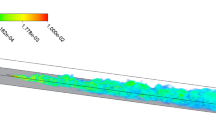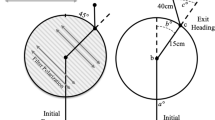Abstract
The lobster,Homarus americanus, relies upon its lateral antennules to make initial directional choices in a turbulent odor plume. To determine whether chemical signals provide cues for source direction and distance during orientation, we studied the search patterns of the lobster orienting within a turbulent odor plume. In an odor plume, animals walked significantly more slowly and most often up the middle of the tank; control animals (no odor present) walked rapidly in straight lines, frequently along a wall. Search patterns were not stereotyped either for the population of experimental animals or for individuals. Three different phases of orientation were evident: an initial stage during which the animals increased their walking speeds and decreased their heading angles; an intermediate stage where both the walking speed and headings were constant; and the final stage close to the source, where heading angles increased while walking speed decreased. During this last stage the animals appear to be switching from a distance orientation (mediated by the antennules) to a local food search (mediated by the walking legs) as evidenced by a great increase in leg-raking behavior.
Similar content being viewed by others
References
Akers, R.P. 1989. Counterturns initiated by decrease in rate of increase of concentration: possible mechanism of chemotaxis by walking female Ips paraconfusus bark beetle.J. Chem. Ecol. 15:183–208.
Atema, J. 1985. Chemoreception in the sea: adaptation of chemoreceptors and behavior to aquatic stimulus conditions.Soc. Exp. Biol. Symp. 39:387–423.
Atema, J. 1988. Distribution of chemical stimuli, pp. 29–56, in J. Atema, A.N. Popper, R.R. Fay, and W.N. Tavolga (eds.). Sensory Biology of Aquatic Animals, Springer-Verlag, New York.
Atema, J., andCobb, J.S. 1980. Social behavior, pp. 409–450, in J.S. Cobb, and B.F. Phillips (eds.). The Biology and Management of Lobster, Vol. I, Academic Press, New York.
Baker, T.C., Willis, M.A., andPhelan, P.L. 1984. Optomotor anemotaxis polarizes self-steered zigzagging in flying moths.Physiol. Entomol. 9:365–376.
Bell, W.J. 1984. Chemo-orientation in walking insects, pp. 93–106, in W.J. Bell, and R.T. Cardé (eds.). Chemical Ecology of Insects, Sinauer Associates, Inc., Sunderland, Massachusetts.
Bell, W.J. andCardé, R.T. 1984. Chemical Ecology of Insects. Sinauer Associates, Inc., Sunderland, Massachusetts.
Bell, W.J., andTobin, T.R. 1982. Chemo-orientation.Biol. Rev. 57:219–260.
Borroni, P., Handrich, L., andAtema, J. 1986. The role of narrowly tuned taste cell populations in lobster (Homarus americanus) feeding behavior.Behav. Neurol. 100:206–212.
Bursell, E. 1984. Observations on the orientation of tsetse flies (Glossinia pallipdipes) to windborne odours.Physiol. Entomol. 9:133–137.
David, C.T. 1986. Mechanisms of directional flight in wind, pp. 49–58, in T.L. Payne, M.C. Birch, and C.E.J. Kennedy (eds.). Mechanisms in Insect Olfaction, Clarendon Press, Oxford. 364 pp.
Derby, C.D., andAtema, J. 1982. The function of chemo- and mechanoreceptors in lobster (Homarus americanus) feeding behavior.J. Exp. Biol. 98:317–327.
Devine, D.V., andAtema, J. 1982. Function of chemoreceptor organs in spatial orientation of the lobster, Homarus americanus: Differences and overlap.Biol. Bull. 163:144–153.
Fraenkel, G.S., andGunn, D.L. 1961. The Orientation of Animals,; 2nd ed. Dover Publishers, New York.
Havukkala, I.J., andKennedy, J.S. 1984. A programme of self-steered turns as a humidity response in Tenebrio, and the problem of categorizing spatial manoeuvres.Physiol. Entomol. 9:157–164.
Hodgson, E.S., andMatthewson, R.F. 1971. Chemosensory orientation in sharks.Ann. N.Y. Acad. Sci. 188:175–182.
Kennedy, J.S. 1978. The concepts of olfactory “arrestment” and “attraction.” Physiol.Entomol. 3:91–98.
Kennedy, J.S. 1982. Mechanism of moth attraction: a modified view based on wind tunnel experiments with flying male Adoxophyes. les Colloq.INRA 7:189–192.
Kennedy, J.S. 1986. Some current issues in orientation to odour sources, pp. 11–25, in T.L. Payne, M.C. Birch, and C.E.J. Kennedy (eds.). Mechanisms in Insect Olfaction, Clarendon Press, Oxford. 364 pp.
Kleerekoper, H. 1967. Some aspects of olfaction in fish, with special reference to orientation.Am. Zool. 7:385–295.
Kleerekoper, H., Timms, A.M., Westlake, G.F., Davy, F.B., Malar, T., Anderson, V.M. 1969. Inertial guidance system in the orientation of the goldfish (Carassius auratus).Nature 223:501–502.
Kramer, E. 1986. Turbulent diffusion and pheromone-triggered anemotaxis, pp. 59–68, in T.L. Payne, M.C. Birch, and C.E.J. Kennedy (eds.). Mechanisms in Insect Olfaction, Clarendon Press, Oxford. 364 pp.
Kúhn, A. 1919. Die Orientierung der Tiere im Raum. Gustav Fischer Verlag, Jena.
Loeb, J. 1891. Über Geotropismus bei Tieren.Pflügers Arch. 49:175–189.
Loeb, J. 1913. Die Tropismen. Hdb. d. vergl. Physiol. Bd. IV. pp. 451–511. Hrsg.: H. Winterstein. Gustav Fischer, Jena.
Loeb, J. 1918. Forced Movements, Tropisms and Animal Conduct. Philadelphia. 209 pp.
Moore, P.A., andAtema, J. 1988. A model of a temporal filter in chemoreception to extract directional information from a turbulent odor plume.Biol. Bull. 174:355–363.
Moore, P.A., Gerhardt, G.A., andAtema, J. 1989. High resolution spatio-temporal analysis of aquatic chemical signals using microelectrochemical electrodes.Chem. Senses 14:829–840.
Murlis, J. 1986. The structure of odour plumes, pp. 27–38, in T.L. Payne, M.C. Birch, and C.E.J. Kennedy (eds.). Mechanisms in Insect Olfaction, Clarendon Press, Oxford. 364 pp.
Murlis, J., andJones, C.D. 1981. Fine-scale structure of odour plumes in relation to insect orientation to distant pheromone and other attractant sources.Physiol. Entomol. 6:71–86.
Payne, T.L., Birch, M.C., andKennedy, C.E.J. (eds.). 1986. Mechanisms in Insect Olfaction. Clarendon Press, Oxford.
Preiss, R., andKramer, E. 1986. Pheromone-induced anemotaxis in simulated free flight, pp. 69–80, in T.L. Payne, M.C. Birch, and C.E.J. Kennedy (eds.). Mechanisms in Insect Olfaction, Clarendon Press, Oxford. 364 pp.
Schöne, H. 1984. Spatial Orientation. Princeton University Press, Princeton, New Jersey.
Reeder, P.B., andAche, B.W. 1980. Chemotaxis in the Florida spiny lobster, Panulirus argus.Anim. Behav. 28:831–839.
Author information
Authors and Affiliations
Rights and permissions
About this article
Cite this article
Moore, P.A., Scholz, N. & Atema, J. Chemical orientation of lobsters, homarus americanus, in turbulent odor plumes. J Chem Ecol 17, 1293–1307 (1991). https://doi.org/10.1007/BF00983763
Received:
Accepted:
Issue Date:
DOI: https://doi.org/10.1007/BF00983763




